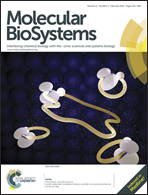Toxicity assessment of Arisaematis Rhizoma in rats by a 1H NMR-based metabolomics approach†
Abstract
Arisaematis Rhizoma (AR), a famous traditional Chinese medicine, has been widely used in Asia over thousands of years. Documented with noticeable toxicity in ancient books, AR has been used to treat various diseases in the clinic. Therefore, it is important to assess the toxicity of AR dynamically and holistically. In this study, a 1H NMR-based metabolomics approach complemented with serum chemistry and histopathology has been applied to investigate the toxicity of AR. Rats were intragastrically administered with AR (0, 0.5 and 1 g kg−1 body weight) for 30 days, and serum and urine samples were collected. Their 1H NMR profiles were analyzed by multivariate pattern recognition techniques to denote metabolic variations induced by AR, and 13 metabolites in urine and 6 metabolites in serum were significantly altered, which suggested that disturbances in energy metabolism, perturbation of the gut microflora environment, membrane damage, folate deficiency and injury of kidneys are produced by AR. Histopathology showed a slight vacuolization of the glomerular matrix and edema of renal tubular epithelial cells in kidneys of AR administered rats, which were evidenced by increased levels of blood urea nitrogen and creatinine in serum chemistry. Our results indicated that oral administration of crude AR was found to induce slight renal toxicity. Therefore, precautions should be made to monitor the potential nephrotoxicity of AR in clinical use. The metabolomics approach provided a promising tool for the study and better understanding of TCM-induced toxicity dynamically and holistically.


 Please wait while we load your content...
Please wait while we load your content...